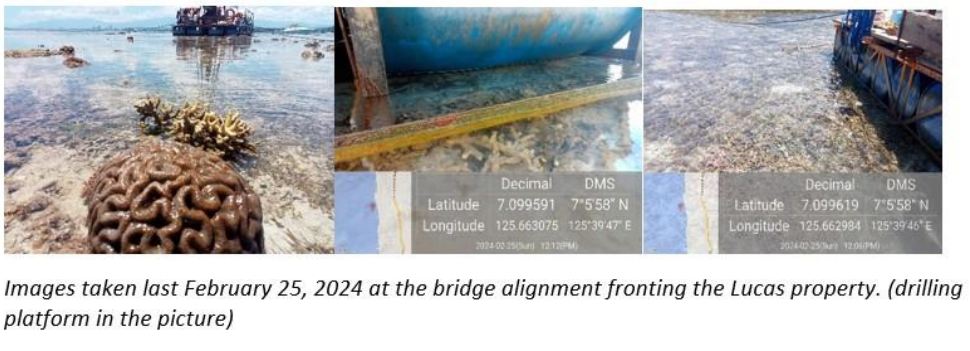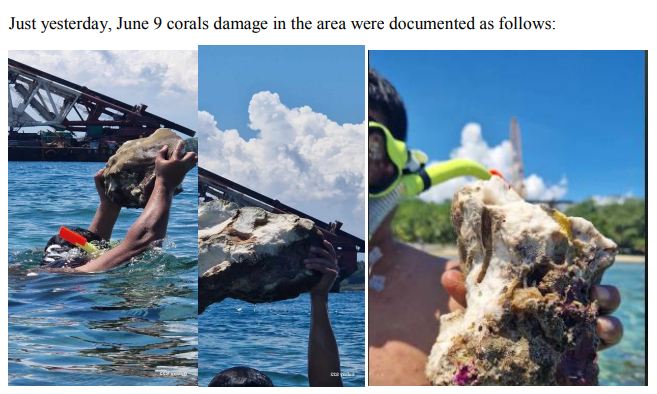
- Environmental group disproves DPWH’s ‘misleading’ claims on coral destruction
AN ENVIRONMENTAL group here debunked the claims of the Department of Public Works and Highways (DPWH) about the Samal Island-Davao Connector (SIDC) bridge project having no impact on corals and marine biology.
Sustainable Davao Movement (SDM), a Davao city-based green group, posted a white paper on Monday, June 10, following the pronouncements of Manila-based DPWH officials during the Kapehan sa Davao on the same day.
“Actually, wala pa tayo sa ganoong situation na meron tayong naapektuhang corals, at any rate kung meron man bibigyan natin siya ng replacement,” Engr. Rodrigo Delos Reyes, DPWH Unified Project Management Office-Bridges Management Cluster (UPMO-BMC) project director, said Monday.
Delos Reyes stressed if the underwater activities commence, they will install “dust curtains” to reduce the negative impact on the corals. Artificial coral reefs will be installed to replace damaged corals, if there are any, which have been successful in other places in the country, citing Batangas for example.
However, according to the group, DPWH gave “misleading and false information” on the environmental impacts and damage brought by the bridge construction to corals.
It added that DPWH has made three “preposterous claims” including no corals were destroyed, the use of curtains to mitigate damage, and the easy replacement of corals if any rate there were damaged.
Destruction of corals ongoing
SDM emphasized that the coral damage has been continuous in four major pre-construction activities that DPWH has undertaken.

This includes soil sample drilling in October 2022; construction of a pier/wharf at the former Blue Jazz property in 2023; soil sample drillings Jan-Feb 2024 at the foreshore area of the Lucas property; and ongoing construction of a “pier/wharf” at the alignment area on Samal side (fronting Lucas property).
SDM added that in 2022 during the groundbreaking, DPWH maintained that “corals are dead” despite the fact the take-off point from Davao which is Hizon is identified as a marine protected area (MPA) and recognized as one of the most productive in the MPA network of Davao Gulf as per World Wildlife Fund (WWF) in 2016.
Meanwhile, the coral condition in the identified landing site is “as good to excellent based on live coral cover and biodiversity” as studied by the group led by Dr. Filipina Sotto2 (with Dr.Cleto Nanola), and another study undertaken by independent Davao-based marine biologist Dr. John Michael Lacson.
A documentation in December 2022 done separately by Dr. Fred Medina and Dr. Lacson revealed a classroom-size of corals damaged in one anchor (out of 4 in one site) at the doorstep of Paradise Reef (across the 2nd jetty). At least 800 sq. m. of corals are expected to be damaged by their soil sample drillings, in the same period.
SDM stressed that as the project conducted a new “pier/wharf” along the bridge alignment on the Samal side, an area along Pts. 89 and 90 are where there is an Acropora valley or a vast spread of hard corals, have been damaged, since the drillings started in January 2024.
It added 12 classroom-size or about 800 sq.m. of corals are expected to be damaged considering the area alone. SDM added as of June 9 latest monitoring, the coral graveyard now at the side of Samal is easily 1 hectare.
“We invite the DPWH team (national and local) as well as the MMT to do a monitoring dive with us and our marine experts to have an honest and serious discussion on what the plans for the corals are,” SDM said.
Silt curtains were and will be ineffective
SDM maintained that if the DPWH used silt curtains, it “apparently did not work” as their December 2022 drillings caused turbidity, siltation, and sedimentation at the Paradise Reef.
“Have these limitations been tested against the current and tides of Davao Gulf, considering that DPWH admitted that they have only just recently finished the design (detailed engineering design of the project)?” it said.
In their letter to DENR XI regional director Bagani Fidel Evasco in Dec 2022, it had documented drilling on top of the corals, a trail of oil and grease, and kitchen waste from the barge, domestic sewages flushed to the sea, and anchorage made on top and through live corals destroying at least 20 sq meters (1 anchor alone) as per Dr. Lacson assessment in Dec 7.
DENR received the letter on Dec. 21 as per the stamp on the copy letter.
No such thing as easy replacement
SDM maintained in its statement coral reef restoration is complex and “requires a whole governance of coral restoration” which they find lacking given that BFAR did not even have plans laid out for the affected fisherfolks of Samal and Davao.
“We believe that the public is intelligent enough to see that centennial table corals cannot be replaced by artificial reefs,” SDM added.
It also questioned the existence of a multi-partite monitoring team (MMT) on April 20, 2023, that did not include any environmental group.
It stressed that progress should not be achieved at the expense of the corals and trees, given the World Environment Day 2024 commemoration.
“The cost of restoration of corals today can easily be at PhP 22,281/sq.m. equivalent to P223-M just on ecological restoration alone. What about fish productivity (Hizon MPA has a biomass of 48.80 metric tons/sq. km.). And what about climate security and the costs of ocean warming?” it said.
The plea
SDM maintained that they are firm in their call to immediate suspension of all construction activities that impact coral reefs until independent marine scientists develop and approve comprehensive environmental assessments and mitigation plans.
They also called for a collaborative restoration effort to be “scientifically sound” and involving marine biologists, conservation organizations, and the community, and enforcing stricter regulations to protect Paradise Reef and Hizon MPA further.
It added that DPWH should also be transparent when reporting the impacts of the project including the damage, and limitations of proposed measures.
“We are on the verge of breaching the 1.5C limit set in the Paris Agreement at COP 21 (December 2015). This year we have been feeling what is now termed global boiling: temperatures so high that health and public safety, food security, and biodiversity are severely compromised,” SDM said.
“This is no time for false narratives and outright lies. When the survival of our children and our planet is at stake, we all must yield to truth-seeking, truth-telling, and truth-defense,” it added.
Images courtesy of SDM Facebook page
